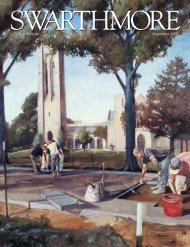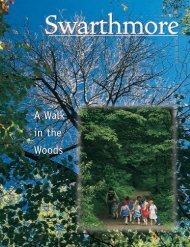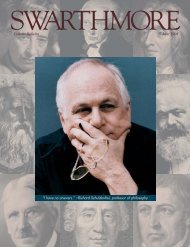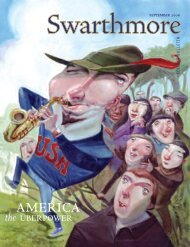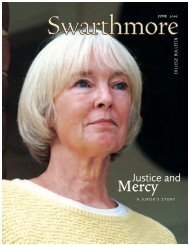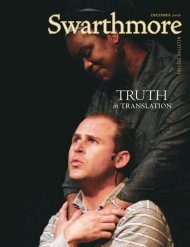Vietnam
Swarthmore College Bulletin (June 2006) - ITS
Swarthmore College Bulletin (June 2006) - ITS
- No tags were found...
You also want an ePaper? Increase the reach of your titles
YUMPU automatically turns print PDFs into web optimized ePapers that Google loves.
collectionPOSITIVELY AGING,GERGEN SHIFTS GEARSA corner office in Papazian Hall—dressed indark paneled wood and brocade draperies—has been the backdrop for Gil and FrankMustin Professor of Psychology KennethGergen’s distinctive career at the College. In40 years, he has seen the campus move fromQuaker tranquility to a vibrant environmentbrimming with stimulating activities. Hesays the richness of classroom dialogue hasincreased as the student body has grown indiversity.Gergen will retire from teaching butremain on campus as a senior research professor.He leaves a legacy of voluminouswritings, student-centered education, an orientationto “social construction” theory, anda concentration in interpretive theory. Hehas also maintained Swarthmore’s connectionsto an international network of scholarsin the field of psychology.On April 22, friends and colleagues gatheredfor a symposium titled “Constructingthe Self” to honor Gergen. Five former studentsaddressed his theories on constructingalternative futures. A presentation by Gergencompleted the afternoon.In the classroom, Gergen focused onhelping students to grow. He says: “I havealways taught the subject [psychology]specifically to broader intellectual and socialissues so students can see how it connects tosociety in general and the internationalmilieu. I’m much less interested in themswallowing lots of facts than in growing anddeveloping in ways that will be of use tothem.”To Gergen, retirement is a transition anda renaissance, which is also the focus of anelectronic newsletter, Positive Aging, that heand his wife, Mary, launched in 2002 andcontinue to write. As he moves into the nextphase of his life, Gergen will continue to lecturein Europe and the United States, completeseveral books that are currently in theworks, and continue as president of the TaosInstitute, an international, nonprofit groupdedicated to education in social constructionisttheory and relational practice, whichhe co-founded.HASSETT HAS BEENA “COMMUNITY BUILDER”From his office in Kohlberg Hall, which provideshim with a delightful view of theIsabelle Bennett Cosby [’28] Courtyard andwhere he is surrounded by books and artwork,John Hassett reflects on his 32 years atSwarthmore: “It has been a wonderful life.I’ve been surrounded by gifted teachers andhave had the joy of being in class withsuperb students.”Susan W. Lippincott Professor of Modernand Classical Languages John Hassettremembers having an average of just three tofour students per class when he joined thefaculty in 1974. He takes great pride in thefact that the program in modern languageshas grown substantially over the interveningyears.The recipient of numerous awards,including the Eugene Lang Fellowship forFaculty Research and the Award for Excellencein Teaching, Hassett has been departmentchair twice. His interest in literaturethat reveals the fabric of society—the politicalrealities, the injustices of repressiveregimes, and the aspirations of citizens—iswell reflected in the book Towards a SocietyThat Serves Its People: The Intellectual Contributionof El Salvador’s Murdered Jesuits, whichhe co-wrote with Scheuer Family ProfessorEmeritus of Philosophy Hugh Lacey in 1991.Scheuer Family Professor of Humanitiesand Professor of German Marion Faberaffectionately describes Hassett’s contributionsto Swarthmore: “He is an impeccableadministrator, blending energy with pragmatism;a strong and caring presence as ateacher—patient, organized, and thorough;and as a colleague, a community builder whoencourages members of the department togather together at the end of the week.”five chooseHassett, who has recently received teachingoffers from Santiago, Chile, and Spain,says: “It’s a funny thing how retirementsneaks up on you, and you need to make adecision about when is the right time tomove on.” For him, it’s now time to travel,continue his research and translating, spendmore time in Chile and Holland with hiswife, and indulge longtime interests in vegetablegardening, restoring old cars, andplaying golf.JAMES MADE TECHNOLOGYEASIER FOR ALLJane James, who retired in December after30 years at the College, will be missed. Fromthe perspective of Eric Behrens ’92, associatedirector of academic computing, “Jane was alight in our midst all along.” Employee RelationsManager Lee Robinson, who served onthe former Benchmark Committee with JaneJames, understands: “Jane is very focused,conscientious, and thorough in everythingshe does. She’s a joy to work with in anycapacity.”Swarthmore has played a major role inthe lives of the James family. The connectionbegan in 1973, when her husband Charles“Chuck” James, Sara Lawrence LightfootProfessor Emeritus of English Literature,was appointed associate professor of Englishliterature.In 1975, James began her tenure at theCollege in a part-time position in the AnnualGiving Office and then moved into a secretarialposition in the President’s Office. In1983, James joined Information TechnologyServices (ITS), then known as the ComputingCenter, as assistant to the director. Shealso served as user services and trainingcoordinator before ending her career as amember of the academic computing team.6 : swarthmore college bulletin



